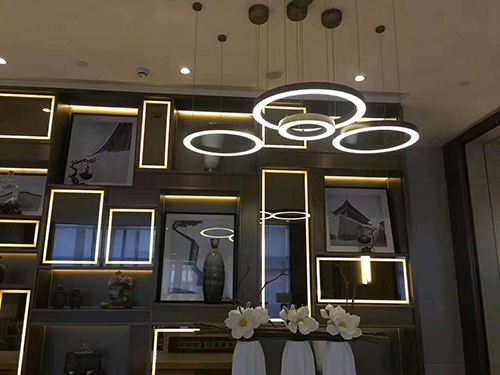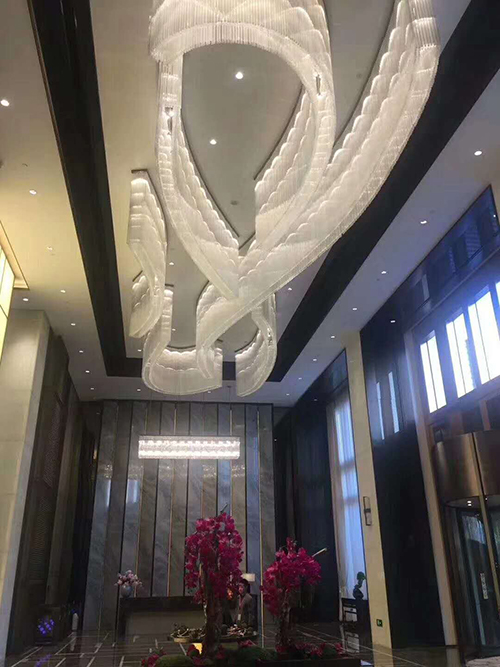East Second Ring Taihe Plaza in Fuzhou, Fujian, as a large – scale commercial complex, its lighting design not only needs to meet basic illumination requirements but also create a unique atmosphere, enhancing its commercial value and urban image. The following is the lighting project solution for this plaza.
1. Project Analysis
East Second Ring Taihe Plaza integrates various functions such as shopping, dining, and entertainment, with diverse architectural forms and spatial layouts, including shopping malls, office buildings, and hotels. It is surrounded by busy traffic and has a large flow of people, and it is an important part of Fuzhou’s night – time economy. Therefore, the lighting design should take into account functionality, aesthetics, and cultural connotations to enhance the plaza’s attractiveness and recognition.
2. Design Concepts
(1) Integration of Regional Culture
Deeply explore the local cultural elements of Fuzhou, such as the architectural style of Sanfang Qixiang and Min – capital cultural symbols, and integrate them into the lighting design. Present the unique charm of Fuzhou through lighting colors, patterns, and shapes, making the plaza a window for spreading regional culture.
(2) Creation of Diverse Scenarios
According to the functions and usage periods of different areas in the plaza, create diverse lighting scenarios. For example, during the day, natural lighting is the main source, and artificial lighting is used to highlight architectural features; at night, create a bustling and lively atmosphere to attract consumers; during special festivals or events, customize themed light shows to enhance interactivity and the sense of experience.
(3) Energy Conservation and Environmental Protection
Adopt energy – efficient LED lighting fixtures and intelligent control systems to reduce energy consumption while meeting lighting effects. Through intelligent dimming, timed switching, and sensor – based control technologies, achieve rational use of energy and respond to the concept of green development.
3. Lighting Design Schemes
(1) Lighting for Building Facades
- Shopping Malls: Use LED strip lights to outline the building’s contours, presenting a simple and smooth sense of lines. In the window areas, install color – changeable LED floodlights, which can change colors and patterns according to seasons and promotional activities to attract passers – by. For the areas around large advertising screens, install high – brightness wall – washer lights to enhance the visual impact of the screens.
- Office Buildings and Hotels: Mainly use warm – white LED floodlights to create a stable and grand atmosphere. At the top of the buildings, install small – scale LED dot – matrix lights, which can display simple texts and patterns, such as corporate logos and welcome messages, to enhance the building’s recognition.
(2) Lighting for Indoor Public Spaces
- Lobbies: As shown by the large – scale characteristic chandeliers in the pictures, customized designs can be adopted, presented in a modern and minimalist or artistic style. Match with embedded LED downlights and light strips to provide sufficient and uniform illumination. The chandeliers can be equipped with dimming functions to adjust brightness and color temperature according to different periods and activities, such as being bright and refreshing during the day and warm and soft at night.
- Corridors and Passageways: Install hidden LED light strips to provide soft indirect lighting, guiding the flow of people while creating a comfortable atmosphere. Set up small – sized wall – mounted lights at certain intervals to increase the spatial hierarchy and decorativeness.
(3) Lighting for Landscape Areas
- Plaza Green Spaces and Flower Beds: Arrange buried LED floodlights to illuminate green plants and flowers, highlighting the beauty of natural landscapes. Select adjustable – angle lights and adjust the irradiation direction according to the growth form of plants. At important landscape nodes, such as around sculptures and fountains, install colored LED floodlights to add an artistic atmosphere.
- Pedestrian Streets: Use aesthetically – pleasing street lamps, which have both lighting and decorative functions. The color temperature of street lamp lights should be warm yellow to create a warm and comfortable walking environment. In front of the shops on both sides of the street, set up small – sized LED spotlights to highlight shop signs and window displays.
(4) Lighting for Special Areas
- Musical Fountains: Combine the shape and spraying rhythm of fountains, and arrange underwater LED color lights and laser lights. Through an intelligent control system, make the lights perfectly match the music and fountains, presenting a brilliant water – show performance. Multiple performance modes can be set, such as the classic music mode and the festival celebration mode.
- Ferris Wheels (if any): Install a large number of LED point – light sources to form rich patterns and animation effects. Through remote control and programming, achieve changes in lighting colors and flashing frequencies, making it a landmark night – view highlight of the plaza.
4. Intelligent Control Systems
(1) Centralized Control
Establish a central control center to manage all lighting equipment in the plaza centrally. Through a computer or mobile terminal, the lighting status can be monitored in real – time, and operations such as switching, dimming, and color – adjusting can be carried out, which is convenient, fast, and efficient.
(2) Scene Presetting
According to different usage requirements, preset multiple lighting scenarios, such as the daily mode, festival mode, and late – night mode. Operators can switch scenes with one click to quickly create a suitable atmosphere. At the same time, new scenes can be temporarily edited and stored according to special events.
(3) Sensor – Based Control
Install human – body sensors and light sensors in some areas, such as underground parking lots and less – frequented passages. When someone enters, the lights automatically turn on or adjust to an appropriate brightness; when there is no one, the lights automatically dim or turn off. Adjust the brightness of the lights automatically according to the ambient light intensity to reduce energy waste.
5. Selection and Installation of Lighting Fixtures
(1) Selection of Lighting Fixtures
- Quality and Performance: Select lighting fixture products from well – known brands with reliable quality to ensure that their luminous efficiency, color – rendering property, service life, and other performance indicators meet the design requirements. For example, the color – rendering index (CRI) of LED lighting fixtures should not be lower than 80 to truly restore the color of objects.
- Protection Level: Select lighting fixtures with appropriate protection levels according to different installation environments. The protection level of outdoor lighting fixtures should reach IP65 or above, with good waterproof, dust – proof, and anti – corrosion performance; lighting fixtures in indoor humid areas also need corresponding protection measures.
- Appearance and Style: The appearance design of lighting fixtures should be coordinated with the overall style of the plaza, such as modern minimalist style or European – style. At the same time, consider the installation location and method of lighting fixtures to ensure that they do not affect the architectural aesthetics and can give full play to the best lighting effect.
(2) Installation Key Points
- Safety Norms: Construct strictly in accordance with electrical installation codes to ensure that lighting fixtures are firmly installed, the wiring is correct, and grounding protection measures are well – done to prevent electric leakage accidents.
- Concealment and Aesthetics: During indoor installation, try to hide the lighting fixture lines in the ceiling and walls to keep the space clean and beautiful. Outdoor lighting fixture installation should pay attention to integration with the surrounding environment to avoid damaging the integrity of the landscape.
- Debugging and Acceptance: After the installation of lighting fixtures is completed, conduct a comprehensive debugging to check whether the lighting effect meets the design requirements, including brightness, color, and irradiation angle. Organize professional personnel for acceptance to ensure that the project quality meets the standards.
6. Maintenance and Management
(1) Regular Inspections
Formulate a detailed inspection plan, and arrange professional technicians to regularly inspect lighting equipment, including the working status of lighting fixtures, the connection of lines, and the operation of the control system. Discover and deal with potential failure hazards in a timely manner to ensure the stable operation of the lighting system.
(2) Cleaning and Maintenance
Regularly clean lighting fixtures to remove dust, dirt, etc., and ensure the light transmittance and heat – dissipation performance of lighting fixtures. For outdoor lighting fixtures, check and clean them in a timely manner after severe weather to prevent the impact on the service life of lighting fixtures due to water accumulation, dust accumulation, etc.
(3) Equipment Updating
With the development of technology and the increase of service life, update and upgrade aging and damaged lighting fixtures and control systems in a timely manner. Pay attention to new technologies and products in the industry, and continuously optimize the performance and effect of the lighting system.
7. Effect Evaluation and Optimization
(1) Establish an Evaluation System
Formulate scientific and reasonable evaluation indicators for lighting effects, including brightness uniformity, color coordination, energy consumption, and user satisfaction. Regularly evaluate the lighting effects of the plaza and collect feedback from consumers and merchants.
(2) Continuous Optimization
According to the evaluation results and feedback, make targeted optimization and adjustment to the lighting system. For example, adjust the brightness of lights, replace inappropriate lighting fixtures, and improve control programs to continuously improve the quality and effect of the lighting project.
Through the above lighting project solutions, East Second Ring Taihe Plaza in Fuzhou, Fujian, will be created as a model of night – view that integrates functionality, aesthetics, and culture, enhancing its commercial value and urban charm.
For further information or cooperation inquiries, please contact:
Email: sales1@hitecdad.com
Phone: +86 – 13922812390
Website: https://www.hitecdadlights.com/
Email: sales1@hitecdad.com
Phone: +86 – 13922812390
Website: https://www.hitecdadlights.com/
Post time: May-30-2025









